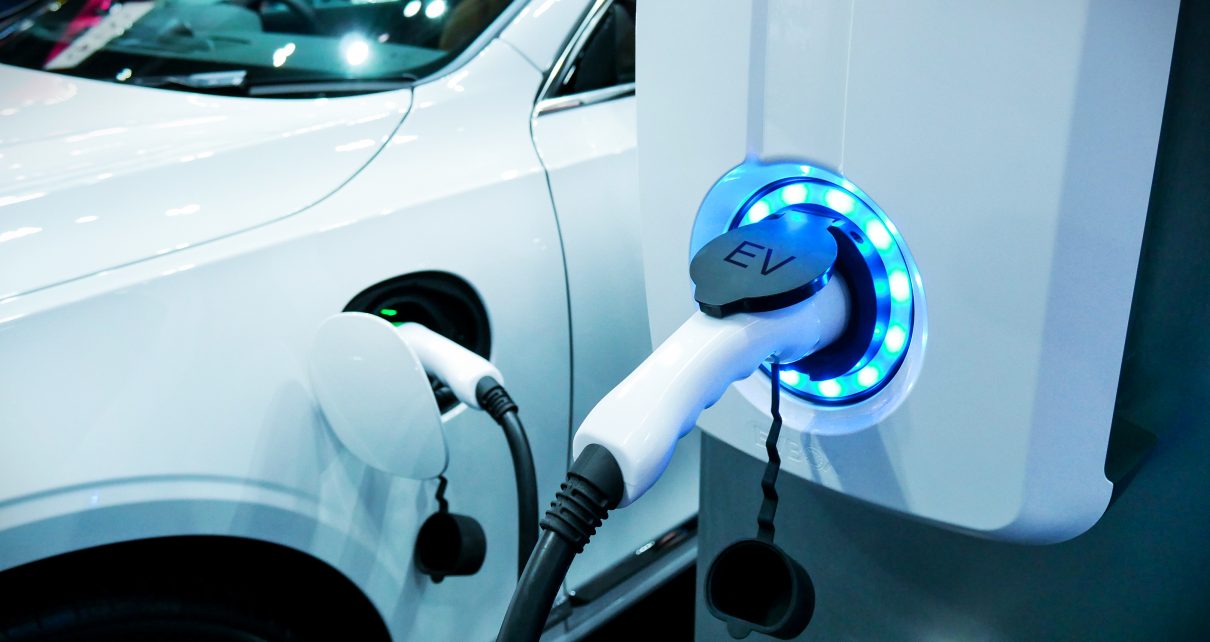
A power supply charging the battery of an electric vehicle. (Photo: Shutterstock/buffaloboy)
Ringside: Quantifying California’s Brave EV Future
California’s legislature is committed to an all-electric transportation sector, but they haven’t come to terms with the details
By Edward Ring, July 25, 2024 3:01 pm
 Earlier this spring Motor Trend published a brief report with a title that revealed more than a little editorializing: “Guess Which State Is Exploring Replacing Gas Taxes With Surveillance?” And of course, that state is California.
Earlier this spring Motor Trend published a brief report with a title that revealed more than a little editorializing: “Guess Which State Is Exploring Replacing Gas Taxes With Surveillance?” And of course, that state is California.
Let’s quickly dispense with some editorializing of our own, so we can move on to the numbers. “Surveillance” is already here. New cars, whether they’re being driven in California or anywhere else in the United States, now come equipped with “driver monitoring systems” that recognize each driver, and create individual driver profiles. They track not only where the car is driven and by whom, but when and where it is driven over the speed limit and any incidences of reckless driving. This data is collected by the manufacturers, who have the right to sell that data. Automobile insurance companies are already among the first clients. When that fun you had airing out the turbocharger on I-5 comes back to haunt you in the form of higher annual premiums, don’t be surprised.
So “surveillance” is the least of our worries. It’s already here. What is really happening is more prosaic. Sacramento wants more money, and a mileage tax is a way to get some. How much money? How many miles? Let’s break it down.
According to the Department of Motor Vehicles, there are 30.8 million cars and light trucks currently registered in California. According to the U.S. Department of Energy, of these, 1.2 million are “BEVs,” that is, pure battery-electric vehicles and not including hybrids that combine gasoline and electric propulsion. Almost all of these BEVs were sold in the past five years, with 374,000 sold in 2023. An overwhelming 60 percent of BEVs sold were Teslas; 226,000 in 2023. The closest rival to Tesla was Chevrolet, selling 19,000 BEVs in the state, followed by Ford, Mercedes, and Hyundai, each of these three companies selling 16,000 BEVs.
A recent article in Newsweek included this quote from Caltrans spokesperson Lauren Prehoda: “On average, Californians pay about $300 a year in state gas taxes; EVs have a $100 (annual) registration fee… that’s a $200 million a year loss.”
We can almost corroborate these numbers. Based on U.S. Dept. of Transportation statistics, Californians will drive 335 billion miles in 2024, and if 96.2 percent of all cars being driven are not BEVs, at an average of 25 miles-per-gallon that equates to 12.9 million gallons purchased, which at 57.9 cents per gallon results in $7.4 billion in state gas tax receipts. That $7.4 billion total is corroborated by the Office of Legislative Analyst. If we divide that 7.4 billion in total gas tax collections by 29.6 million non-BEV vehicles, that’s $250 in gas tax per car.
As for lost gas tax revenue, assuming California’s 1.2 million BEV owners log the same amount of mileage as non-BEV owners, about 11,000 miles per year (total VMT divided by total vehicles), if they were driving non-BEVs and getting 25 miles-per-gallon, California would collect an additional $300 million in gas tax. Taking away the $108 fee that BEV owners pay for the privilege of driving BEVs in California, and that $300 million loss is cut to $180 million. So CalTrans says $200 million will be lost this year thanks to BEVs; from the ground up we estimate $180 million is to be lost. That’s close enough for jazz.
But so what? A $200 million loss equates to a 2.7 percent shortfall. That’s peanuts, isn’t it?
Not really. It depends on how soon BEVs gain significant market share. And this is the multi-billion question. It’s not clear how or when they will, because one might argue that everyone who wants to own a BEV has already bought one. Sales records have been broken every year, but growth in 2024 vs. 2023 was less than 2023 vs 2022, and market share is still under 5 percent. That’s too early for year-over-year rates of growth to slacken unless something’s wrong. Why did Hertz sell off a third of its BEVs? Why did Ford cut back production of its BEV F-150? Why are Tesla sales down 10 percent in Q4 of 2023 compared to Q4 of 2022?
A fascinating study from SJSU’s Mineta Transportation Institute offers several transportation revenue scenarios for California. Released in March 2024, the study makes some predictions that you have to respect, if for no other reason, for their inherent optimism. In some of their most likely scenarios, they claim the total vehicle mileage per person will actually increase in the coming years, and the three reasons they offer for this are vintage California dreaming (in a good way):
1 – “The cost of driving will fall considerably due to some combination of cheaper operating costs for electric vehicles,
2 – there will be a major increase in vehicle sharing at low cost through Mobility as a Service models, and,
3 – widespread adoption of autonomous vehicles that facilitates growing travel by reducing the disutility of time spent in vehicles.
As someone who appreciates the utility of adaptive cruise control and lane following, it is hard to argue with the third point. Overall, if this mainstream study is any indication, our benevolent central planners are planning on everyone driving more miles, becoming more mobile, as Californians nonetheless blaze the way towards a utopian green future. Maybe it’s not all bad.
But will California actually manage to increase the number of public quick-charge stations from the current 93,000 to over 1 million by 2030, and over 2 million by 2035? Will solid state batteries and other emerging technologies arrive, allowing charge times of under 15 minutes in exchange for ranges over 500 miles? How else will Californians be induced to purchase BEVs in numbers ten times what we’ve seen so far? Because that’s what it’s going to take to get to a 50 percent share of BEVs on the road.
And if all that occurs, will there be enough electricity? As it is, we may expect BEVs to log around 13 billion miles on California roads this year. At 3.5 kilowatt-hours per mile, that will only burn through 3,700 gigawatt-hours, which is only about 1.3 percent of the not quite 300,000 gigawatt-hours we’re likely to use this year. But if 50 percent of cars on California roads were BEVs, we’d need 48,000 additional gigawatt-hours, plus a ten-fold increase in the high-voltage distribution lines needed to deliver fast charging to millions of impatient motorists.
California’s legislature is committed to an all-electric transportation sector, but they haven’t come to terms with the details. At this time, the charging technology, the generating capacity, and the power distribution network remain inadequate to support the state’s planned rapid transition to mostly BEVs.
Making up for lost gas tax revenue is the easy challenge to overcome. Just increase the BEV registration fee from $108 per year to $300 per year. Problem permanently solved. No new bureaucracy. No new taxes or fees on everybody else. It won’t change the inevitable fact that we are all destined to be remotely surveilled as we drive, nor the mitigating fact that at least all that computational power will lower the “disutility of time spent in vehicles.”
- Ringside: Reversing California’s Policies of Scarcity - January 8, 2026
- Ringside: What is the Future of California’s Republican Party? - December 31, 2025
- Ringside: CA GOP Just Blew $46 Million for Nothing – Here’s How They Can Avoid Repeating That Mistake in 2026 - December 24, 2025





“California’s legislature is committed to an all-electric transportation sector, but they haven’t come to terms with the details.”
C’mon Ed, details get in the way of the virtue-signal and the UN/WEF Agenda 2030 guidelines…
Plus, the more expensive and inconvenient we
make it all, the more people will leave and help save the environment for the Newsom/Getty/Brown ruling class….
Keep in mind that Hyundai has been busted faking their sales numbers. My guess is that the rest of the manufacturers And the government are also inflating their numbers. In the Green world “it is the way”.